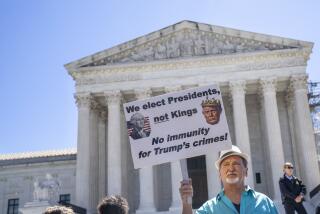Supreme Court says 40-foot Maryland cross can stand as war memorial
- Share via
Reporting from Washington — The Supreme Court said Thursday the Constitution did not require tearing down historic monuments just because they featured religious symbols, such as crosses or the Ten Commandments.
In a 7-2 decision, the high court upheld the display of a nearly century-old, 40-foot cross that sits on public land at a busy Maryland intersection just a few miles east of Capitol Hill.
The justices ruled that the World War I-era monument, known as the Peace Cross, could stand as a war memorial honoring local soldiers and was not an unconstitutional promotion of a favored religion.
The case posed the first test of church-state separation since President Trump’s two appointees joined the court. But Thursday’s decision did not chart a new, more conservative course on religion. Instead, the justices, including two liberals, stressed the importance of history and tradition. As a result, their opinion does not offer encouragement to local and state officials to erect new religious displays on public property.
Speaking for the court, Justice Samuel A. Alito Jr. said the Maryland cross was erected in 1925 as a tribute to 49 soldiers who died in World War I, and it can be upheld because it serves many purposes.
“The cross is undoubtedly a Christian symbol,” he said in American Legion vs. American Humanist Assn. “But that fact should not blind us to everything else that the Bladensburg Cross has come to represent. For some, that monument is a symbolic resting place for ancestors who never returned home. For others, it is a place for the community to gather and honor all veterans and their sacrifices for the nation.”
The age of the monument was a key factor, he said. “Retaining established, religiously expressive monuments, symbols and practices is quite different from erecting or adopting new ones,” Alito said. “The passage of time gives rise to a strong presumption of constitutionality.”
Justices Stephen G. Breyer and Elena Kagan, two of the court’s liberals, concurred in the outcome. Breyer said the decision upholding “the Peace Cross poses no real threat to the values the Establishment Clause serves.” The 1st Amendment forbids “an establishment of religion” by the government, and it has been understood to bar an official preference for one religion.
“I fully agree with the court’s reasons for allowing the Bladensburg Peace Cross to remain as it is,” Kagan wrote. The court’s “opinion shows sensitivity to and respect for this nation’s pluralism, and the values of neutrality and inclusion that the 1st Amendment demands.”
Thursday’s outcome closely tracks Breyer’s lone view from 2005 when the court ruled on two cases involving the Ten Commandments. He joined a 5-4 ruling with the liberals to block Kentucky officials from prominently posting the Ten Commandments in government offices. But he then joined a 5-4 conservative ruling that preserved a nearly 50-year-old granite monument that stood almost unnoticed on the grounds of the Texas state Capitol. Tearing down the old monument would be seen as reflecting a “hostility toward religion,” Breyer said then in a comment quoted by Alito.
Justices Clarence Thomas and Neil M. Gorsuch did not join Alito’s opinion, and both said they would have gone further and made it nearly impossible for citizens to sue to challenge religious displays by the government. Thomas repeated his view that the 1st Amendment applies only to the federal government and does not prevent states or localities from favoring religion.
Gorsuch said the court should abandon the “offended observer theory of standing” and throw out suits filed by people who are upset by religious displays on public property. “Really, most every governmental action probably offends somebody,” he said, adding lawsuits should be triggered by actual injuries.
Justices Ruth Bader Ginsburg and Sonia Sotomayor dissented. Ginsburg read her dissent in the court and said the “1st Amendment demands governmental neutrality among religious faiths and between religion and non-religion. Today the court erodes that neutrality principle,” she said. “If the aim of the Establishment Clause is genuinely to uncouple government from church, the clause does not permit a display of the character of Bladensburg’s Peace Cross.”
For decades, the Supreme Court has struggled to decide whether and under what circumstances local governments may display religious symbols on public property. These have included Christmas displays with depictions of Jesus’ birth and granite monuments with the Ten Commandments.
Shortly after Justice Brett M. Kavanaugh took his seat, the court agreed to hear the Maryland cross case in hopes of clarifying the law.
The cross was built with private funds in the early 1920s to honor soldiers who were killed in Europe. Since 1961, however, it has been maintained on public property by the park commission for Maryland and the national capital area.
About five years ago, three residents said they objected to seeing the cross towering over the intersection when they drove by, and they joined a lawsuit with the American Humanist Assn. They said they did not want the monument to be torn down but instead moved to private property. They lost before a federal judge but won a 2-1 ruling from the 4th Circuit Court of Appeals in Virginia.
“The monument here has the primary effect of endorsing religion and excessively entangles the government in religion,” wrote Judge Stephanie Thacker for the appeals court. “The Latin cross is the core symbol of Christianity. … Therefore, we hold that the purported war memorial breaches the ‘wall of separation between Church and State,’” she said, quoting words of Thomas Jefferson that were adopted by the court in 1947.
In November, the Supreme Court agreed to hear appeals from the American Legion, which had defended the memorial, and from the regional parks commission.
Alito said that religion is infused with American history and a “campaign to obliterate” it would be divisive. “For example, few would say that the state of California is attempting to convey a religious message by retaining the names given to many of the state’s cities by their original Spanish settlers — San Diego, Los Angeles, Santa Barbara, San Jose, San Francisco, etc. But it would be something else entirely if the state undertook to change all those names,” he wrote. “Much the same is true about monuments to soldiers who sacrificed their lives for this country more than a century ago.”
More stories from David G. Savage »
More to Read
Get the L.A. Times Politics newsletter
Deeply reported insights into legislation, politics and policy from Sacramento, Washington and beyond. In your inbox three times per week.
You may occasionally receive promotional content from the Los Angeles Times.











